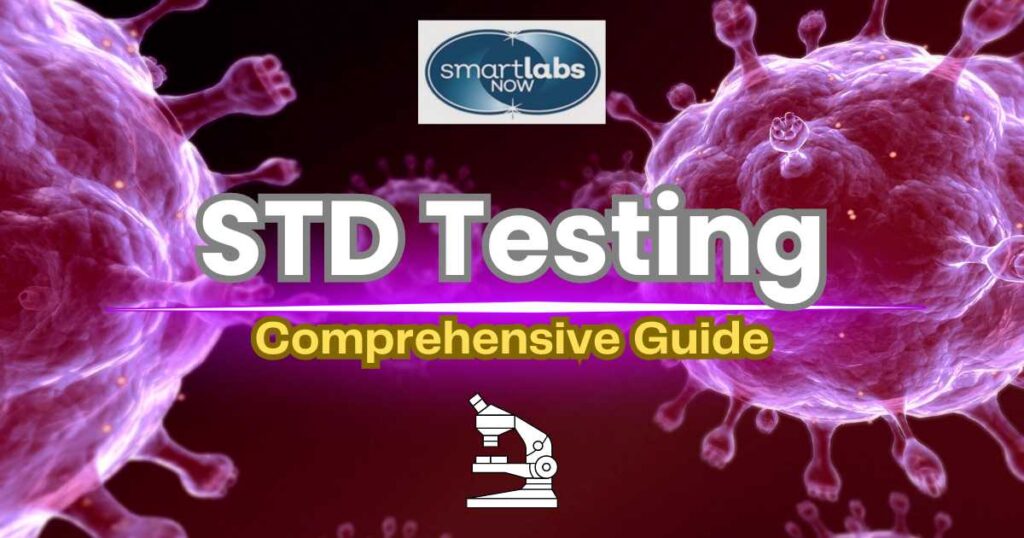
Sexually transmitted diseases (STDs) are infections primarily spread through sexual contact. They affect millions globally, leading to health complications like infertility, chronic pain, and even life-threatening conditions such as HIV/AIDS.
Early detection and timely treatment are crucial in managing STDs and preventing transmission.
Blood tests play a vital role in the diagnosis of many STDs. Unlike visible symptoms, which may take time to develop, blood tests can detect infections early—sometimes before symptoms appear.
This guide will explain different types of STD blood tests, how to interpret results, and practical considerations when getting tested.
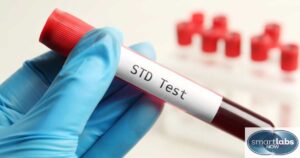
An STD panel test (the broad-coverage type we offer at Smart Labs Now 🤓) is a comprehensive examination designed to detect multiple sexually transmitted infections in one go. These tests typically screen for common STDs like HIV, syphilis, gonorrhea, chlamydia, and hepatitis B and C.
Advantages: STD panels provide a broad look at multiple infections, making them ideal for routine screening or after unprotected sex. They are convenient and eliminate the need for multiple visits to a healthcare provider.
Disadvantages: Panels may include tests for infections you’re unlikely to have, potentially increasing costs.
Rapid tests offer a quick and convenient way to screen for STDs, often providing results within 20 minutes. They are available at clinics and even for home use. Rapid tests include point-of-care tests (performed in a medical setting) and finger prick tests, which can detect infections like HIV or syphilis.
Pros: Rapid results, non-invasive, ideal for those who need quick answers.
Cons: Rapid tests may be less sensitive than lab-based tests, especially in the early stages of infection. Many doctors don’t recommend them.
Instant STD tests function similarly to rapid tests but deliver results even faster, typically within minutes. These are convenient for those seeking immediate answers, often offered in mobile clinics or pharmacies.
Availability and Limitations: While faster, they are limited in scope and accuracy compared to laboratory tests. Instant tests are usually reliable for screening but might require follow-up testing for confirmation. Again, many physicians are hesitant to recommend these in place of lab screenings.
Urgent care centers offer walk-in testing services, making them a convenient option for individuals seeking same-day testing without scheduling an appointment.
Convenience: Fast access, especially for those with symptoms or concerns.
Potential Wait Times: Busy centers may still require a wait, and definitive results may require follow-up tests. Lab testing, in contrast, is generally a much swifter experience.
In emergencies, such as severe STD symptoms (e.g., pain, high fever), an emergency room (ER) may provide testing. However, ER visits are costly, and STD tests are not always the priority unless symptoms are severe.
Costs: Higher than typical STD testing sites.
When to Seek ER Testing: If symptoms are acute and require immediate medical attention.
At-home STD tests provide a convenient and discreet option for individuals seeking screening. These tests typically involve a swab, urine sample, or saliva sample that is collected at home and then sent to a laboratory for analysis.
Pros:
Cons (Major):

A negative result means no STD was detected in the sample. However, a single negative test may not be conclusive if the test was taken too soon after exposure.
Interpreting Negative Results: Timing matters. For example, HIV and syphilis tests may not detect the infection until weeks after exposure.
Follow-Up Testing: Re-test after the appropriate window period for conclusive results, especially if symptoms persist.
Symptoms Despite Negative Results: Some infections may not show up on early tests. Consult a healthcare provider if symptoms continue.
A positive result indicates that an infection is present. It’s important not to panic, as many STDs are treatable with medications, and early detection significantly improves outcomes.
Implications: A positive test means treatment is necessary, and you should inform any recent sexual partners.
Treatment Options: Antibiotics (for bacterial STDs like chlamydia or gonorrhea) or antiviral treatments (for viral infections like HIV or herpes).
Prevention Strategies: Safe sexual practices (condoms, regular testing) are key to preventing future infections.
Timing: Testing too soon after exposure may lead to false-negative results due to the “window period,” where infections are present but undetectable.
Medications/Conditions: Some medications or health conditions may interfere with test accuracy. Always inform your healthcare provider of any medications you’re taking.
Reporting Sexual History: Accurate and honest disclosure of your sexual history ensures that the right tests are administered.
Example Case 📚: Understanding Chlamydia Test Results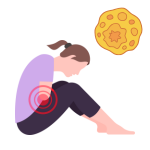 Understanding the specifics of Chlamydia trachomatis—the bacteria responsible for the infection—is essential when interpreting chlamydia test results. Here, we explore what constitutes a negative result and the potential health implications of a positive diagnosis. Negative Test Result A negative test result indicates no detectable Chlamydia trachomatis in the sample, suggesting the absence of an active infection. However, this result doesn’t offer permanent immunity, as chlamydia can be contracted again after treatment. Those at high risk should consider regular testing to ensure ongoing sexual health. Positive Test Result A positive test confirms the presence of Chlamydia trachomatis, necessitating treatment to prevent health complications. Left untreated, chlamydia can lead to pelvic inflammatory disease (PID), which is linked to long-term conditions such as chronic pelvic pain and tubal factor infertility (infertility caused by damage to the fallopian tubes). PID is also a risk factor for ectopic pregnancy, where a fertilized egg implants outside the uterus, which can be life-threatening. Associated Health Conditions For women, untreated chlamydia can lead to cervicitis (inflammation of the cervix), a condition that may go unnoticed but still contribute to PID. In men, chlamydia can cause urethritis (inflammation of the urethra), resulting in painful urination and discharge. Both genders may also experience proctitis (inflammation of the rectum) if chlamydia affects the rectal area. Sample Collection and Test Accuracy Chlamydia testing typically involves collecting samples from the urethra, cervix, or rectum, depending on the individual’s symptoms and risk factors. Proper sample collection is essential for accurate results, as inadequate samples may produce false negatives, necessitating retesting if symptoms persist. Overall, early testing and treatment are critical to prevent complications and safeguard reproductive health. Regular screening is especially advised for individuals with multiple partners or a previous chlamydia diagnosis to detect and address reinfections promptly. |
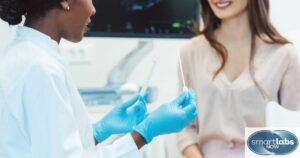
| TEST TYPE | PROCEDURE |
|---|---|
| Blood | Blood tests are commonly used to detect blood-borne infections like HIV, syphilis, and hepatitis. No special preparation is typically needed, though fasting may be required for specific tests. |
| Oral | Oral infections, like herpes simplex virus, can be detected through blood tests or swabs. Oral swabs are quick and reliable but not as commonly used as blood tests. |
| Swab | Genital, rectal, and throat swabs are effective in detecting STDs like chlamydia, gonorrhea, and herpes. These tests involve collecting samples from the infected area. |
| Pap Smear | A Pap smear screens for cervical cancer and can detect some STDs, like HPV. Additional STD tests may be required for comprehensive results. |
| Urine | Urine tests are non-invasive and can detect infections like gonorrhea and chlamydia. |
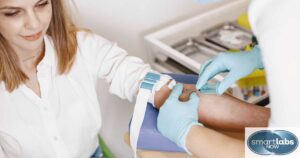
Before undergoing STD testing, it’s essential to prepare adequately to ensure accurate results. Here are some key considerations:
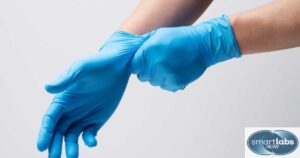
A healthcare provider will visually examine your genitals, including the penis, scrotum, vulva, and anus, for any signs of infection, such as sores, warts, or discharge.
A urine sample can be used to test for chlamydia, gonorrhea, and trichomoniasis. You will be asked to provide a clean urine sample in a sterile cup.
A swab is a cotton-tipped applicator that collects cells from the affected area. This is commonly done for tests such as:
A blood sample is drawn from a vein in your arm to test for:

Cost of STD Tests: Many health insurance plans cover STD testing. For those without insurance, free or low-cost testing options are available through community clinics or planned parenthood facilities.
Discreetly Requesting an STD Test: Privacy is a concern for many individuals. Be open with your healthcare provider, as most testing services are confidential, and respect your privacy.
Testing During Menstruation: Menstruation doesn’t affect STD blood tests, but swab tests may be more difficult during this time. Consult your healthcare provider for recommendations.

Discussing sexually transmitted infections (STIs) with your partner can be a sensitive topic, but it’s crucial for maintaining your sexual health and the health of your partner. Open communication about STIs demonstrates respect for each other’s well-being and can help prevent the spread of infections.
Before initiating a conversation, it’s essential to assess your individual risk factors for STIs. Factors such as the number of sexual partners, unprotected sex, and a history of STIs can influence your risk. Understanding your personal risk can help you approach the conversation with a more informed perspective.
In a new relationship, it’s often helpful to introduce the topic of STI testing early on. A casual and honest approach can make the conversation less intimidating. You might say something like, “I think it’s important to be open about our sexual health. Have you been tested for STIs recently?”
Open and honest communication is vital when discussing STI testing. Avoid making assumptions or judgments. Instead, focus on sharing information and expressing your concerns. Be willing to listen to your partner’s perspective and address any questions or concerns they may have.
If either partner receives a positive STI test result, it’s important to approach the situation with empathy and understanding. Seek professional guidance from a healthcare provider to discuss treatment options and prevention strategies. Remember that STIs are treatable, and with proper care, the infection can be managed effectively.
Regardless of the outcome of STI testing, it’s essential to respect each other’s well-being. Avoid blaming or shaming your partner. Instead, focus on supporting each other and taking steps to protect your health.
Some common risk factors for STIs include:
Regular STI testing should be considered a routine part of healthcare, especially for sexually active individuals. It’s recommended to get tested annually or more frequently if you have multiple sexual partners or engage in high-risk behaviors.
Sexual health encompasses both physical and emotional well-being. Discussing STIs and practicing safe sex are essential components of maintaining good sexual health. By prioritizing open communication and responsible sexual behavior, you can protect yourself and your partner from STIs.
Sharing your sexual history with your partner can help them understand your risk factors and make informed decisions about their own health. It’s important to be honest and open about your past sexual experiences.
Many STIs are treatable with medication. If you or your partner receive a positive test result, seek professional guidance from a healthcare provider to discuss appropriate treatment options. Adhering to the prescribed treatment plan is crucial for eliminating the infection and preventing further transmission.
Consistent and correct use of condoms is one of the most effective ways to prevent the transmission of STIs. Encourage your partner to use condoms during sexual activity, and make sure you both know how to use them correctly.
By openly discussing STI testing and practicing safe sex, you can significantly reduce your risk of contracting or transmitting STIs and maintain a healthy sexual relationship.

Symptoms may indicate another condition or an infection undetectable during early stages. A follow-up test might be necessary.
No. STD tests must be specifically ordered; they do not appear in routine blood work.
No, boric acid treatments for conditions like yeast infections do not affect STD blood test results.
If you tested during the “window period,” a follow-up test may be needed. Otherwise, negative results are generally conclusive.
Blood tests take minutes to administer; depending on the test type, results can take a few hours to a week.
Positive results indicate infection. A negative result means no infection was detected, though follow-up may be required.
Yes, blood donation centers screen for HIV, syphilis, and hepatitis, but they won’t provide personal test results unless an infection is detected.
Testing timing depends on the infection. For HIV, the testing recommendation is at least 2-4 weeks post-exposure.
No infection was detected.
Out-of-range refers to abnormal results requiring further investigation.
Yes, menstrual cycles don’t affect blood tests for STDs.
No, pregnancy tests are separate and unrelated to STD screenings.
No, UTI tests do not detect STDs, although some symptoms may overlap.

STD blood tests are a crucial tool for diagnosing sexually transmitted infections and ensuring timely treatment. By understanding the various testing options, interpreting results accurately, and taking preventive measures, you can protect your health and the health of others.
Proactive care—through regular screening and safe sexual practices—ensures a healthier, more confident future.
Please consult your primary care physician before engaging with any pharmaceutical, natural substances, or activity regimens mentioned or prescribed in this post. Smart Labs Now is not responsible for any health or life outcomes resulting from the use of the information or recommendations provided. This account does not serve as a substitute for professional medical advice.